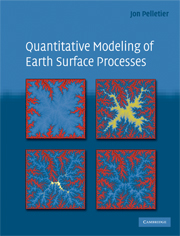Book contents
- Frontmatter
- Contents
- Preface
- Chapter 1 Introduction
- Chapter 2 The diffusion equation
- Chapter 3 Flow routing
- Chapter 4 The advection/wave equation
- Chapter 5 Flexural isostasy
- Chapter 6 Non-Newtonian flow equations
- Chapter 7 Instabilities
- Chapter 8 Stochastic processes
- Appendix 1 Codes for solving the diffusion equation
- Appendix 2 Codes for flow routing
- Appendix 3 Codes for solving the advection equation
- Appendix 4 Codes for solving the flexure equation
- Appendix 5 Codes for modeling non-Newtonian flows
- Appendix 6 Codes for modeling instabilities
- Appendix 7 Codes for modeling stochastic processes
- References
- Index
- Plate section
Chapter 1 - Introduction
Published online by Cambridge University Press: 05 June 2012
- Frontmatter
- Contents
- Preface
- Chapter 1 Introduction
- Chapter 2 The diffusion equation
- Chapter 3 Flow routing
- Chapter 4 The advection/wave equation
- Chapter 5 Flexural isostasy
- Chapter 6 Non-Newtonian flow equations
- Chapter 7 Instabilities
- Chapter 8 Stochastic processes
- Appendix 1 Codes for solving the diffusion equation
- Appendix 2 Codes for flow routing
- Appendix 3 Codes for solving the advection equation
- Appendix 4 Codes for solving the flexure equation
- Appendix 5 Codes for modeling non-Newtonian flows
- Appendix 6 Codes for modeling instabilities
- Appendix 7 Codes for modeling stochastic processes
- References
- Index
- Plate section
Summary
A tour of the fluvial system
The fluvial system is classically divided into erosional, transportational, and depositional regimes (Schumm, 1977). In the Basin and Range province of the western US, Cenozoic tectonic extension has produced a semi-periodic topography with high ranges (dominated by erosion) and low valleys (dominated by deposition). In this region, all three fluvial-system regimes can be found within distances of 10–20 km. As an introduction to the scientific questions addressed in this book, we start with a tour of the process zones of the fluvial system, using Hanaupah Canyon, Death Valley, California, as a type example (Figure 1.1).
Large-scale topography of the basin and range province
The large-scale geomorphology of the Basin and Range is a consequence of the geometry of faults that develop during extension and the subsequent isostatic adjustment of each crustal block. In the late Cretaceous, the Basin and Range was an extensive high-elevation plateau, broadly similar to the Altiplano-Eastern Cordillera of the central Andes today. When subduction of the Farallon plate ceased beneath the western US, this region became a predominantly strike-slip plate boundary and the horizontal compressive force that supported the high topography and over-thickened crust of the region could no longer withstand the weight of the overlying topography. The result was regional extension (Sonder and Jones, 1999). The structural style of extensional faulting varies greatly from place to place in the western US, but Figure 1.2 illustrates one simple model of extension that can help us understand the topography of the modern Basin and Range.
- Type
- Chapter
- Information
- Quantitative Modeling of Earth Surface Processes , pp. 1 - 29Publisher: Cambridge University PressPrint publication year: 2008



